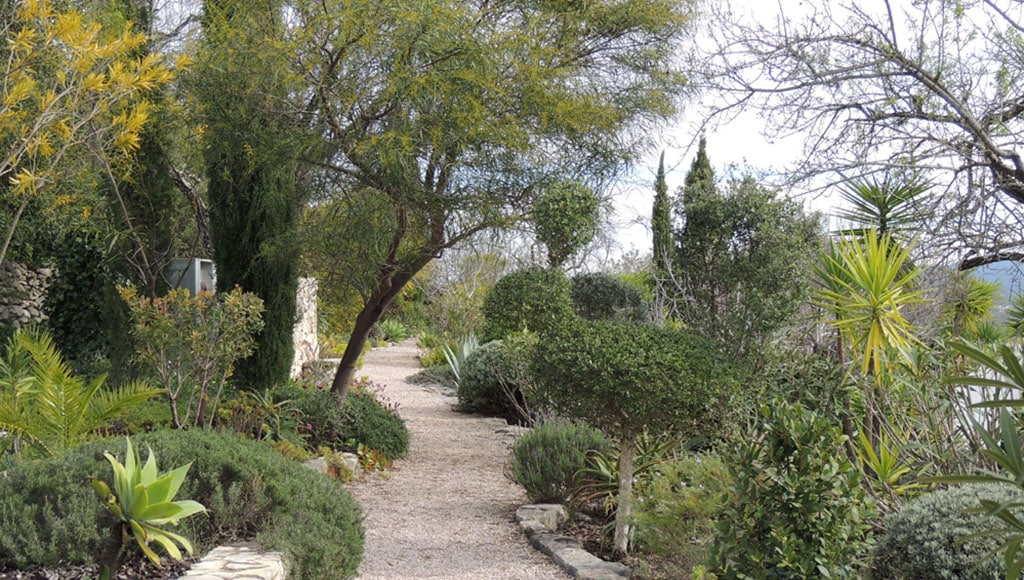Now that the long hot days of summer are with us, it is time to plan for the new gardening year. New gardens and new planted areas can be considered, but they will need to have access – both for the gardener and to enjoy the changing aspects of the seasons.
For you to create a garden path that is as beautiful as it is practical, consider your needs before you start construction. A path allows you to take a leisurely stroll through your garden, but it also serves as access for work and maintenance.
Decisions should be made before you start work, including important technical decisions, compacting the ground and type of edging as well as final choice of topping. You can vary between a formal or informal look for different parts of the garden.
The classic way to start is to use a garden hose to outline a route. It is easier to move a hose around than it is to change direction once you start construction. This often happens when a lawn is removed and replaced with ground cover planting.
Desire lines exist, in public spaces and private. The shortest route to the washing line, compost bins or the BBQ will usually be taken, whether or not it is via a path. So, if you are not sure of an exact route, why not create a wider area, when a path can become a gravel garden? Taking a garden path between large rocks creates a bit of tension and interest and is common practice in Japanese-style gardens.
Make your garden path at least 1.25m wide. Two people should be able to walk comfortably side by side on the path. The more traffic, the wider the path, and consider adding a smooth slope between the steps for wheelbarrows.
Add some curves – remember, there are no straight lines in nature! Paths that follow any contours are easier to use and can avoid steps altogether by using gentle ramps. A slightly meandering path adds interest and creates a sense of relaxation as well as creating planting spaces. But remember to keep it simple; a path that winds around too much is just annoying.
Varying the materials also adds interest. For example, use gravel or shredded plant material for informal areas where path edges will merge into the planting. For high traffic areas, choose more solid materials such as calçadas, bricks, stepping stones, or large flat stones. It is possible to combine gravel with stones to give spaces for low-growing plants.
You need to remember what happens when it rains – leave some permeable surface for water absorption and to avoid causing erosion on slopes. Mediterranean gardens do not have lawns and so this is an opportunity to decorate your outside spaces with hard landscaping using local materials. Portuguese calçadas are a fabulous design feature and instantly give a ‘sense of place’ (genus loci).
Incorporate lighting if you plan on using your path after dark. Solar lights can be placed 2m to 3m apart. The aim is to light your path for safe passage after the sun goes down, not transform it into an airport runway and ruin your view of the heavens. Mark where you might wish to have a pipe laid under the path for any watering systems or cables.
Focal points positioned at the end of paths help to draw the eye up, provoking curiosity and providing a visual clue to the destination. Focal points can include a special tree, garden benches, shady corners and large plant containers or somewhere to view the sunset, glass in hand …
Planting ideas
When the path is finished and you are ready to start planting, one of the glories of a mediterranean garden is that we can consider using plants from all the other mediterranean climate zones as well as from the wider Mediterranean basin.
Plant choices depend on what you plan for the rest of the gardens, but using aromatic herbs and sub shrubs gives you perfume as you pass by. For reliable ground cover, depend on evergreens to flank your garden path such as low-growing rosemary and the ground-hugging native Cistus crispus. Remember that plants will grow over path edges, so do not plant too close to where you wish to walk.
- Fragrance from aromatic herbs such as thyme, helichrysum and lavenders.
- Ground cover succulents for drought-resistant colour and texture, e.g. Graptopetalum.
- Perennial Dianthuspyrenaicus ‘Cap Bear’ offers fragrant blooms.
- Silver foliage plants add textural interest and drought tolerance, e.g. Santolina viridis.
- Small iris spread quickly and have lovely blooms. Iris albicans has white flowers.
- Liriope muscariis a favourite of Japanese gardens.
- Pachysandra terminalis grows thick enough in shade to choke out weeds.
- Sedum is available in many sizes and colours. sediforme is a native as is Vinca difformis which provides pretty blue flowers through the winter.
Enjoy planning during the summer without moving away from the shade!
By Rosie Peddle
|| features@algarveresident.com
289 791 869 | mgapsec@gmail.com
facebook.com/MedGardenersPortugal
www.mgaportugal.org




















